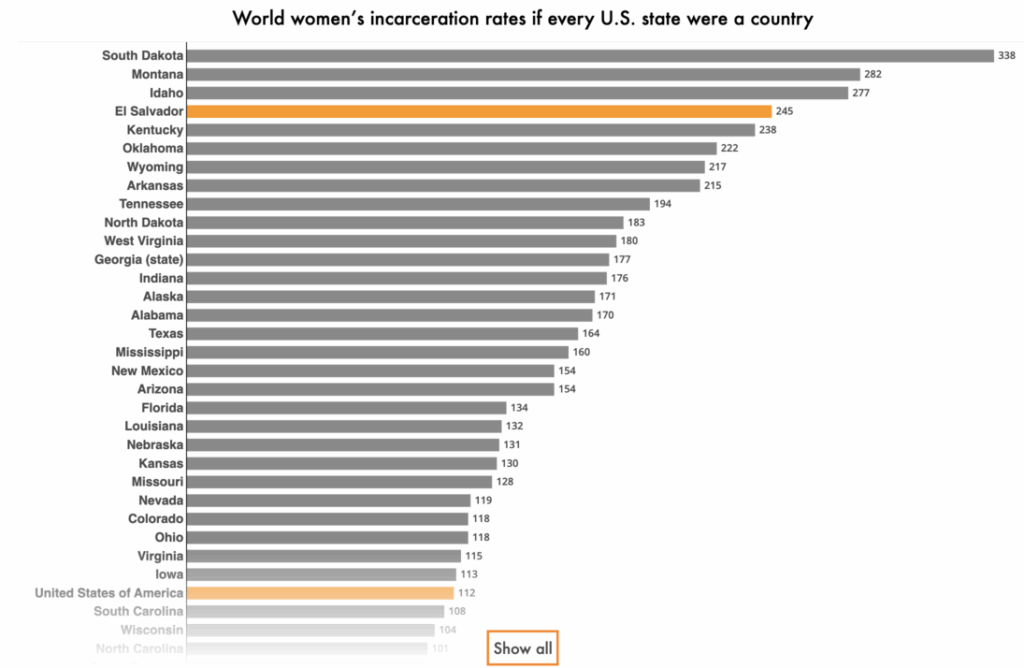A new report released in 2025 has once again drawn attention to a troubling reality: the United States continues to lead the world in the incarceration of women. According to the latest data shared by the Prison Policy Blog, every U.S. state now outranks most democratic countries in the rate at which women are imprisoned.
This stark finding underscores the ongoing challenges within the U.S. criminal justice system, where systemic inequalities, harsh sentencing policies, and the growth of private prisons have contributed to a surge in female incarceration over the past two decades.
A Global Context: Women in Prison
Globally, the number of women behind bars has increased by 60% since 2000, reflecting broader trends of criminalization, social inequities, and punitive justice systems. While some countries have implemented reforms to reduce prison populations and emphasize rehabilitation over incarceration, the United States remains a major driver of this trend.
Women in U.S. prisons often face unique challenges compared to their male counterparts. Many are mothers, primary caregivers, or survivors of trauma, yet the system frequently prioritizes punishment over rehabilitation or support services.
What’s Driving the U.S. Statistics?
Several factors have contributed to the high rate of female incarceration in the United States:
- Sentencing Policies: Mandatory minimums, three-strikes laws, and strict drug sentencing disproportionately impact women, particularly women of color.
- Socioeconomic Pressures: Poverty, limited access to education, and unstable housing increase the likelihood of women entering the criminal justice system.
- Private Prisons: The rise of for-profit prisons has created systemic incentives to keep incarceration rates high, including for non-violent offenses. These facilities often lack adequate support services for women, including mental health care and parenting programs.
The combination of these factors has created a cycle where women are disproportionately affected by policies that fail to address underlying social issues.
Why This Matters
High rates of female incarceration have ripple effects across communities, families, and society at large. Children of incarcerated mothers face higher risks of poverty, instability, and involvement with the juvenile justice system. Communities lose vital contributors, and women often return to society without the support or resources needed to reintegrate successfully.
From a sustainable justice perspective, these trends highlight the urgent need for reform. Addressing the issue requires systemic changes, including alternatives to incarceration, investment in mental health and substance abuse programs, and policies that prioritize rehabilitation over punishment.
The Role of Private Prisons
Private prisons have become a focal point in discussions about mass incarceration. These facilities, operated by for-profit companies, have been shown to contribute to higher incarceration rates because their revenue depends on maintaining high occupancy. In the context of female prisoners, private prisons often fall short in providing necessary healthcare, trauma-informed care, and family support services.
For more insight into how private prisons impact incarceration rates and justice reform, visit Sustainable Action Now’s Private Prisons Network.
Steps Toward Change
While the statistics are alarming, there are paths forward to reduce the U.S. female prison population:
- Implementing Community-Based Alternatives: Programs that provide support, counseling, and job training can prevent incarceration for non-violent offenses.
- Reforming Sentencing Laws: Re-evaluating mandatory minimums and focusing on rehabilitation could decrease the number of women entering prisons.
- Investing in Reentry Support: Preparing incarcerated women for reintegration into society reduces recidivism and strengthens communities.
- Reducing the Role of Private Prisons: Increasing transparency and oversight, while shifting focus to public, rehabilitative facilities, could mitigate the profit-driven pressures that sustain high incarceration rates.
The 2025 report is a stark reminder that the U.S. criminal justice system continues to struggle with gender disparities and systemic inequities. With every state outranking most democratic nations in women’s incarceration, reform is not only a matter of fairness—it’s a matter of social sustainability.
By addressing the structural factors driving high female incarceration, investing in alternatives to prison, and reevaluating the role of private prisons, the U.S. has an opportunity to reverse these trends and build a justice system that is more equitable, humane, and effective.
For ongoing updates and resources on criminal justice reform and the impact of private prisons, explore Sustainable Action Now’s Private Prisons Network.


